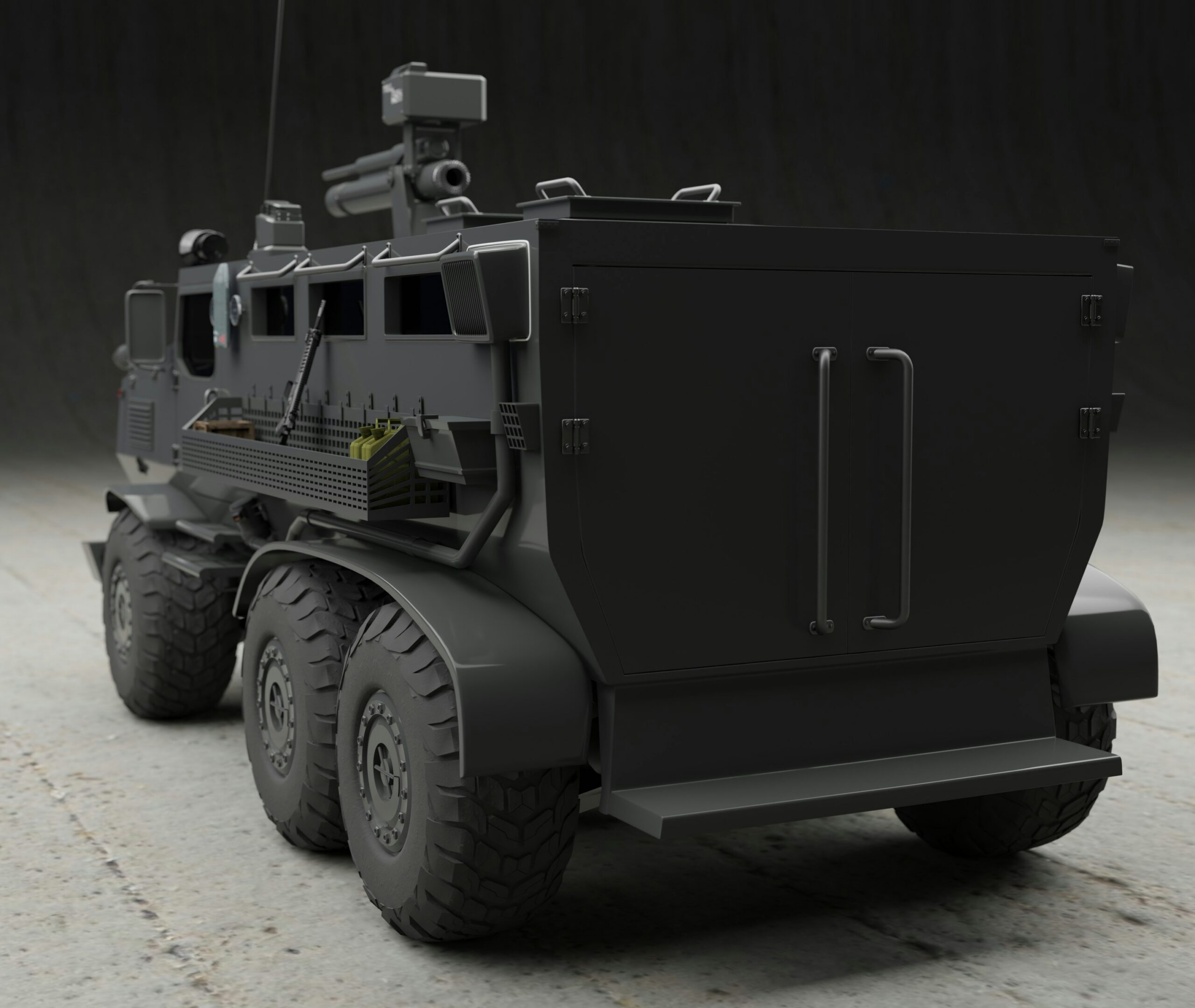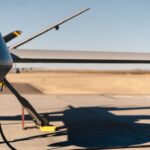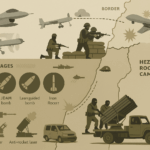This major step arrived after several years of careful evaluation. Planners looked at shortcomings in earlier fleets, and they saw an opportunity to modernize. The older cargo trucks and outdated patrol vehicles no longer met the standards needed for present-day threats. Officers wanted stronger defenses. They also needed reliable platforms that can adapt to multiple roles: troop transport, field engineering, medical support, and more.
Background on the Belrex PCSV and Fleet Purpose in SAF
In November 2016, the Singapore Army introduced a platform called the Belrex Protected Combat Support Vehicle (PCSV). It appeared as a direct response to the army’s need for an upgraded vehicle that could replace the older five-ton trucks and the older MB290 transports. Collaboration took place between the Defence Science and Technology Agency (DSTA) and a major engineering firm known for its expertise in vehicle production. The Belrex PCSV was touted as a big leap forward in tactical support.
Analysts have pointed out that the Belrex PCSV’s entry into service coincided with a broader modernization campaign similar to recent efforts like the joint bid by Arquus and Daimler Truck to modernize the French military truck fleet. The vehicle’s design emphasized crew protection and varied mission support. Commanders wanted a vehicle that can function in different environments without taking on extensive modifications each time. They also prioritized the integration of new technology for communications and situational awareness. By employing advanced systems, the army sought to ensure a faster flow of information across all operational levels.
The Belrex PCSV departed from conventional transport designs. It offered a sturdy frame, ballistic plating, and a monocoque V-shaped hull aimed at redirecting blasts away from critical components. Military observers described it as an example of forward-thinking engineering. Past incidents with improvised explosive devices convinced officials that upgrading protective measures was non-negotiable. Soldiers can now operate in high-risk zones without the same exposure they faced with earlier platforms.
Belrex PCSV Variants, RWS Armament & V-Hull Protection
Military experts looked at several areas when finalizing the Belrex PCSV’s specifications. Some points were considered must-haves:
- High Payload Capacity: Each vehicle can support loads of up to 4,000 kg. Planners wanted enough room to carry everything from basic supplies to heavier equipment such as mortar rounds or field medical gear. This emphasis on modular capacity created a single platform that can be reshaped for multiple tasks.
- Improved Firepower: The Belrex PCSV comes with a remote-controlled 7.62mm machine gun. A soldier can handle this weapon from the cabin. That reduces personal risk since no one needs to expose themselves for targeting.
- Multiple Variants: There are at least ten available configurations, including those built for engineering tasks, logistics, medevac, security, mortar transport, and signal operations. Each variant caters to a specific mission profile. Crews no longer need a completely different vehicle if they switch from one kind of support role to another.
- Enhanced Command and Control: The Belrex PCSV uses advanced systems that link it to the broader Army Battlefield Internet (ABI) network; a similar network integration was seen in French special forces’ use of the Euroflir observation system. This setup helps keep units aligned. Soldiers know where allied positions are, and they can share critical updates in near real time.
- Robust Mobility and Protection: The PCSV is built for speed and endurance. It reportedly reaches 110 km/h at top speed and can travel up to 600 km without extra refueling. The armor can resist ballistic threats and helps limit damage from blasts underneath the chassis.
Further details are available at the official Ministry of Defense portal. Engineers involved in the project have mentioned the importance of localized production. They designed the PCSV with local terrain in mind, ensuring it can handle uneven paths and muddy stretches. The vehicle’s suspension and traction systems have been tested under tough conditions to prove reliability.
Standardized Support Fleet to Replace Legacy Cargo Trucks
Leaders of the Singapore Army realized they had to push modernization further. Regional developments indicated a shift in how armed forces handle mobility and logistics. Modern combat demands quick deployment of specialized teams—medical, engineering, reconnaissance, and more—directly to points of need. Traditional platforms were either too slow or lacked proper shielding. That caused concerns about casualty rates and supply vulnerabilities in tense areas.
Officials saw that a standardized vehicle series could address multiple gaps. A single base platform, such as the Belrex PCSV, can be converted from a simple cargo carrier to a front-line ambulance or a mortar ammunition transport. That cuts costs by avoiding the need to invest in several specialized fleets. Maintenance becomes simpler because the same fundamental parts fit each variant, so the logistical tail is less complicated. The entire force stands to benefit from faster readiness and easier training.
In addition, troop morale gets a boost from an improved sense of safety. Soldiers want to know their vehicles can protect them against explosive devices or ambushes. Operational success often depends on the ability to reach the conflict zone intact. A robust support vehicle allows them to conduct missions with more confidence. That was another reason behind the push to induct these specialized platforms.
Field Trials Feedback
Units that tested the Belrex PCSV in field exercises noted that the vehicle’s new digital systems allow real-time monitoring of ground conditions. Field officers can upload map data, request artillery support, or coordinate supplies with minimal delay.
The PCSV’s robust armor package has also attracted positive responses. Commanders see it as a step up from prior trucks. They note that it can operate on challenging terrain without sacrificing speed. Crew members appreciate the interior layout, which was planned to reduce fatigue on long missions. The seats have extra padding, and the compartments include special mounts for weapons and communication gear.
Logistics personnel mention the practicality of the PCSV’s cargo space. They can load vital equipment for a quick setup in the field. Examples include mortar shells, communications kits, or medical stretchers. Medical teams find it useful to transform the platform into a mobile casualty station with enough room for immediate care.
Broader Defense Vision
The induction of these protected combat support vehicles forms part of a wider blueprint the Singapore Army has outlined for the next decade. Modern technology is being integrated into almost every combat system. The Belrex PCSV is one piece of that puzzle. There are also new reconnaissance drones, advanced personal armor, and updated communications networks. All these changes aim to give each unit an enhanced edge in both conventional and asymmetric engagements.
Officials have stated that the region’s security outlook is not static. Threats evolve, and so must the army’s capabilities. That requires constant innovation and a commitment to thorough research. Partnerships with local industry also remain essential. Defense planners prefer homegrown solutions that meet the country’s distinct needs, rather than relying on off-the-shelf imports that might not match local realities.
A few details about cost have surfaced. Observers say that advanced materials and added protective features do require significant funding. The army, however, believes that effective soldier protection and mission readiness outweigh any immediate budget concerns. They see the Belrex PCSV as a long-term investment, with some vehicles projected to remain in service for many years.
Operational Versatility
Another reason behind the push for these new vehicles lies in their ability to adapt to unpredictable missions. The Belrex PCSV can support disaster relief in addition to combat tasks. When storms or floods strike, the same vehicle that serves as a troop carrier can be fitted with rescue tools and medical supplies. That adaptability makes it valuable for civil support, humanitarian operations, or even peacekeeping missions beyond national borders.
Moreover, its modular design accommodates advanced sensors and remote-controlled systems. It can carry surveillance equipment or specialized detection devices for mines. It broadens the army’s response range to threats like improvised explosive devices. There is also talk of future expansions, where certain variants could include directed-energy defenses or more advanced counter-IED technology.
Training and Readiness
Crews must be well-trained to handle the advanced digital systems on board. Singapore’s training programs now include simulator-based instruction. Recruits become familiar with the PCSV’s controls in virtual scenarios, then move on to real-world drills. Senior officers believe that bridging theory and practice in a structured manner helps new operators adapt faster.
Technicians also receive updated coursework. They learn about the PCSV’s mechanical features, software configurations, and safety systems. That specialized knowledge ensures timely repairs if a vehicle suffers damage in the field. Maintenance teams keep spare parts on hand, and any large-scale overhauls happen at central depots. The entire chain is designed to keep a high readiness level.
Role in Combined Operations
The Singapore Army envisions these vehicles working alongside tanks, infantry carriers, artillery units, and aerial assets. When multiple forces converge, the PCSV’s communication links become crucial. Commanders have an easier time controlling different elements if everyone shares the same data platform. This synergy allows a single mission to unfold without confusion.
Observers have drawn parallels between this approach and the network-centric warfare models seen in more advanced militaries. By improving connectivity, the Singapore Army reduces the risk of friendly-fire incidents and speeds up response times. Soldiers in the field have credited the new vehicles with unifying support functions. Instead of piecemeal coordination, they see a more seamless style of combined operations.
Budgeted Fleet Growth & Lifecycle Modernization
Officials have hinted that more vehicles of similar or upgraded design might join the force in upcoming years. Researchers continue studying new materials, from lightweight alloys to advanced composites. This focus on research is partly motivated by the push to keep pace with global trends. Defense watchers say that unmanned ground vehicles could be the next step, although those plans remain under wraps.
Some have asked whether the Belrex PCSV might be sold to friendly nations. Official statements are vague, but industry experts believe that export versions could appear if foreign militaries show enough interest. There is precedent for local defense firms in Singapore marketing products abroad. Any potential deals would require government approval. For now, local deployment remains the main priority.
Steady Investment in Security
Money allocated to these vehicles reflects Singapore’s broader commitment to defense modernization. Officials say that strategic resilience begins with ensuring frontline troops have the right equipment. Commanders remain cautious about the region’s unpredictable challenges. By bringing in these robust platforms, the army aims to stay prepared for multiple scenarios. That includes conventional warfare, low-intensity conflicts, and non-combat emergencies.
The public also seems supportive, especially since the PCSV’s capabilities include peacekeeping or humanitarian missions. Public trust in the military remains high when they see flexible tools that can handle both conflict and crisis situations. Community relations programs highlight the fact that these vehicles are not built solely for combat. They offer wide-ranging benefits if natural disasters strike.
Conclusion of Initial Report
Singapore’s decision to induct new protected combat support vehicles signals a clear intent: keep pace with modern threats and ensure every mission receives the support it needs. Soldiers can move with confidence, protected by advanced armor and integrated systems. The Belrex PCSV has already proven its worth as a next-generation solution for various combat and support roles. Military analysts predict that these vehicles will remain a central feature of Singapore’s defense posture for years.
Belrex PCSV Data Links, Encrypted Comms & Sensor Suite – March 2025 Update
Defense planners have released fresh information on recent enhancements to the Belrex PCSV series. Engineers carried out an upgrade program earlier this year as highlighted during the Singapore Airshow demonstration of next-generation protected vehicles. The Singapore Army has confirmed that these improvements focus on digital integration, crew comfort, and sensor add-ons. Officials stated that the entire fleet will receive these upgrades by late 2025.
Sources close to the development team reported that new data links have been integrated into each Belrex PCSV. The upgrade supports expanded connectivity with unmanned aerial vehicles, giving operators an instant feed of battlefield imagery. Commanders can coordinate more precisely if they spot unknown threats in the path of advancing ground units. The entire system draws on an updated network architecture that handles larger volumes of encrypted data.
Another update pertains to onboard communications. Soldiers inside the PCSV can use refined voice-activated controls to switch between local talk channels and higher command networks. The redesigned interface also sports an interactive touch panel for quick reference to intelligence reports. Field officers claim that these improvements reduce the time needed to relay requests or receive feedback. Plans are in place to retrofit older units so that no vehicle lags behind in technology.
Army representatives have mentioned the introduction of an augmented reality (AR) device for certain Belrex PCSV variants. This AR system enables a driver or commander to see virtual markers overlaid on the real environment. The overlay can highlight potential obstacles or safe routes, especially during night operations. Trials have shown that these enhancements reduce driver errors and improve mission efficiency.
There are also new comfort features aimed at making long deployments more bearable. Crews found that extended operations caused fatigue in older vehicles. The newly introduced seats have higher-density padding with adjustable lumbar support. Another detail concerns cabin airflow. Ventilation units have been refined to maintain stable temperatures even in tropical climates. Maintenance teams say these changes will not complicate vehicle upkeep. They see it as a welcome adjustment that helps with troop endurance.
Reports indicate that some variants gained specialized sensor pods. Reconnaissance teams mentioned a thermal imaging camera that swivels 360 degrees. This pod can automatically track moving objects. Night scouting missions become safer because the crew can watch areas that might conceal enemy forces. Army insiders say these additions did not require an overhaul of the vehicle’s power systems, owing to the efficient design of the sensors.
Singapore’s Ministry of Defense has emphasized that the Belrex PCSV remains a core part of the country’s security framework. Though the baseline model was introduced nearly a decade ago, officials remain determined to keep it relevant.
With these improvements, the Belrex PCSV continues to stand out among modern combat support vehicles. Analysts believe that this March 2025 update program reaffirms the army’s goal of staying prepared for shifting security needs. The defense community will watch to see how these vehicles perform in upcoming multinational exercises, especially since the new data links might give allied forces a more detailed picture of combined operations.More details can be found at the Singapore Army Information Portal. Observers expect additional statements in the months ahead, along with demonstrations showing off the latest software and hardware improvements.
REFERENCE SOURCES:
- https://militaryleak.com/2024/02/28/st-engineering-unveils-next-generation-protected-vehicle-ngpv-at-singapore-airshow/
- https://www.army-technology.com/projects/belrex-protected-combat-support-vehicle-pcsv/
- https://www.mindef.gov.sg/news-and-events/latest-releases/25nov16_fs
- https://www.defencetalk.com/singapore-inducts-new-protected-combat-support-68618/
- https://defence-blog.com/european-engineers-review-singapores-ngpv-vehicle/
- https://www.army-technology.com/news/singapore-army-hunter-armoured-fighting-vehicle/
- https://en.wikipedia.org/wiki/Hunter_AFV
- https://www.asianmilitaryreview.com/2025/01/singapore-army-commissions-hunter-armoured-engineer-vehicle-foc/



